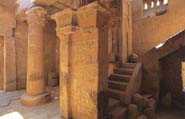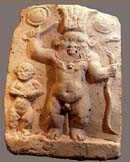Books on Ibiza
Bibliomaniacs' Corner
by Martin Davies
The Story of Bes (Part One)
Throughout recorded history, human beings and unsolved mysteries have enjoyed
a close - and often financially-rewarding - relationship. Of special relevance
to bibliomaniacs is an enigma which has not only outpaced the rediscovery of Noah’s
Ark, but also kept statues on Mars and divinely-encoded bibles firmly on the back-burner.
The Hall of Records, as it is called, is an elusive archive which can hardly be
left out of our bookish tour of Ancient Egypt. It was first glimpsed on 29th October
1933 during a deep trance by the great Kentucky clairvoyant Edgar Cayce (1877-1945).
Over the following dozen years the Sleeping Prophet continued to receive additional
data regarding its fabulous age and provenance. In recent years his findings have
attracted a worldwide following, thanks to the considerable literary talents of
John Anthony West (see Part Seventeen) and Graham Hancock, author of five alternative-prehistory
bestsellers, including Keeper of Genesis (1996). For these and a growing
band of bibliozealots, the Hall lies a tantalizing fifty feet beneath the Giza
Sphinx. It contains, besides a potted history of Atlantis, a sort of global survival-kit
which the sages of yore thoughtfully put aside to allow mankind to weather the
self-inflicted catastrophes of modern times: This
Hall of Records - when discovered - will have a profound effect upon the world!
It will change our perception of many of our ideas and will, at one stroke, rewrite
our history books and upgrade and revolutionise our scientific know-how. Many
people believe that this Hall of Records will be discovered in the fairly near
future. When the Hall of Records is eventually opened we shall, at long last,
have all the evidence we need to prove the existence of Atlantis. At that time
we shall then discover that Atlantean technology and knowledge was far more advanced
than we had hitherto thought possible! Nuclear
weapons, landmines, ozone-holes and genetically-engineered food - all swept firmly
into the cupboard like the wayward toys of Mary Poppins. It would certainly be
none too soon. On a more serious note, could the Hall of Records have a real-life
alias? We have been looking at rediscovered scrolls in Herculaneum and the lost
libraries of Alexandria, Carthage and Rome. What are the chances that Egypt’s
dry atmosphere might not have preserved something special for us booklovers? In
fact the entire country is an archival repository - hieroglyphs, papyri and ostraka
(inscribed stone and pottery fragments) surviving by the million, easily outstripping
any other location on the planet. Conventional Egyptology once focused on the
accessible dynastic inscriptions, but in recent years the fascinating details
of everyday life have been emerging thanks to the Herculean labours of backroom
translators. One of the principal sources was located in a New Kingdom village
of exceptionally literate craftsmen who built the tombs in the Valley of the Kings
outside Thebes (several hundred miles upriver from Old Kingdom Giza). It was here
in 1950 that French archaeologist Bernard Bruyère stumbled not upon a Hall
but a well of records. The village in question is now known as Deir el-Medina
or ‘Monastery of the City’, but its original name was Set Maa, ‘the
Place of Truth’ - a euphemistic reference to the nearby Necropolis. The dryness
of the surrounding terrain made it a fitting locale not only for royal mummies
but also the world’s oldest book, The Teaching of Ptah-Hotep, commonly
known as the Prisse Papyrus after its discoverer, Émile Prisse d’Avennes
(1807-79). It also ensured that the shaft of a projected village well was a particularly
deep one: soon after the founding of Set Maa in 1550 BC an attempt was made to
reach the water table. After descending 150 feet the villagers gave up & over
the following five hundred years used the bottomless pit as a rubbish dump.

Temple of Het-Hert At Deir el-Medina | It
thus became the final resting-place for about thirty thousand rock-shard 'notepads'
- laundry lists, love songs, employee absences, receipts, legal settlements and
ruminations about gods and dreams. 'They were incredibly bureaucratic,' as one
investigator has observed. Could they possibly be related to the Spanish? |

Unique mural of Bes from the tomb of Senneferi, Thebes, 1420 BC |
As the most talented craftsmen in the civilized world, the
villagers of Deir el-Medina could hardly resist decorating their dwellings inside
and out with furnishings and frescoes. The commonest motif was the god Bes, a
versatile deity associated not only with childbirth, dancing, music, dreams and
fertility but later on with Ibiza (‘the Island of Bes’) because of its
miraculous lack of snakes and scorpions. Such creatures were known to shun the
presence of the ferocious talismanic dwarf - just as malevolent spirits fled before
his astonishing ugliness: a grotesque face, a curly beard or mane, lion-like ears,
a lion’s tail, a prominent belly and bandy legs. The overwhelming majority
of Carthaginian coins minted on our island bear his bizarre anthropoid features.
His name, incidentally, may be related to besa, the panther whose skin is often
draped over his shoulders and whose head appears as a pendant. The charismatic
deity is the protagonist of Shelli Wright Johnson’s recent children’s
book, The Story of Bes (2000 - to be reviewed in a fortnight), which includes
a foreword by John Anthony West, the subject of our last article (Weekly Edition
083). Bes also takes centre stage in Jean-Charles Pichon’s Le Jeu de Bes
(2001), a novel set in present-day France which combines an ingenious plot with
generous doses of mythology and ancient history. It so happens that our dwarf
god also shares some interesting characteristics with the Giza sphinx: both have
a mixture of leonine and human features and both enjoyed protective roles
vis-à-vis the royal house of Egypt… and just possibly their
treasured books. Hmmmn. |

Bes and Beset, Ptolemaic period, Saqqara Necropolis |
|
| To
conclude, let us take a closer look at ancient plural cases. The Phoenician name
for Ibiza - Ybshm - means either the ‘Islands of Bes’
with a Semitic plural ‘m’ (as in ‘cherubim and seraphim’)
or just possibly the ‘Island of the Beses’ (we will ignore for
the present a rival etymology - ‘The Islands of Aromatic Pines’). The
latter would be a reference to the original nuclear family, Bes plus female consort
(Beset) and two little scamps (Boy Bes and Girl Bes). Could those last-named rascals
have something to do with the impish barruguets unique to Ibiza which we
came across in Weekly Editions 056 & 058? Bes and the Pityusan archipelago
are not the only ancient entities whose plural cases are often swept under the
carpet: according to our Sleeping Prophet, the Hall of Records also existed at
the same time as two companion archives - one in Yucatan, and a third which disappeared
beneath the waves at the same time as Atlantis. Hancock is convinced he has just
found the latter off Japan and his forthcoming blockbuster, Underworld,
will provide more details. Let us wish the maverick investigator economically-rewarding
diving. By the way, Bes’s temple-sanctuary remains to be found on Ibiza.
Wannabe Harrison Fords should drop by in a fortnight’s time for a few tips. |
Scarab from Carthage showing
Bes holding a (scape) goat with flanking papyri stems (rattles for scaring away
demons). | | http://www.beazley.ox.ac.uk/Gems/Scarabs/Script/Scarab3.12.htm
form the first two sections of an impressive online
catalogue of Phoenician scarabs set up by Oxford University’s Beazley Archive:
eighty-three Beses from collections around the world spearhead this project, one
of the largest collections of images yet published of ancient Ibiza’s protective
deity (see illustration above). Statues of Bes and his lesser-known consort from
a variety of different website are shown below.
|
| |
|
|
|
| Lamp with Bes and Beset, terracotta.
Favum | Bes |
Egyptian faience Bes amulet |
Ceramic statue of Bes found at Kawa (Nubia) in 2000 |
| |
|
|
| Bronze figure of Pantheistic Bes,
644-525 BC | Egyptian faience
amulet, 664-525 BC. | 664-525
BC. A turquoise amulet of the god Bes, naked, with hands at his side and wearing
a plumed headdress. |
| | |
| Wooden tablet of Bes
holding papyrus-stem rattles, New Kingdom (Brussels, Musées Royaux) |
Bes |
| Martin
Davies
martindavies@ibizahistoryculture.com
|
|
|
| Ibiza
Authors
| | | | | | | | | | | | | | | | | | | | | | | | | | | | | | | | | | | |
|
|
Book Reviews
| | |
|
Children's Books
| | | | | | | | | | |
| | | Biographical
Portraits | | | | | | | | Gaston
Vuillier | | | | | | | | |
| Novels,
Old & New | | | | | | | | | | |
| | | | | | | | | |
| Egypt
and Ancient Ibiza | | | | | | | | | | |
|
|